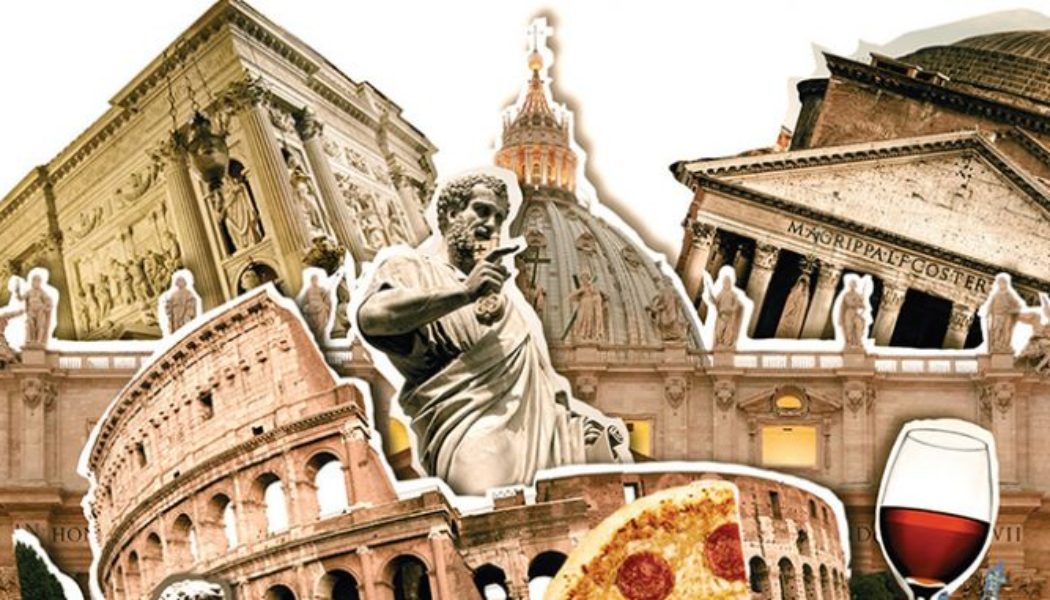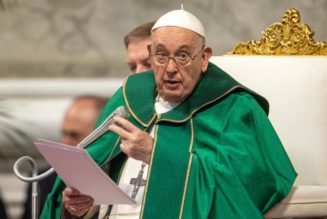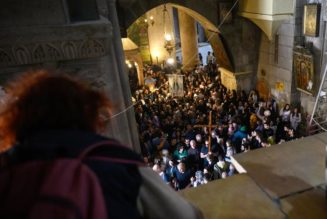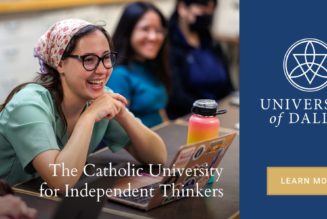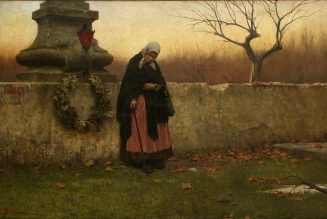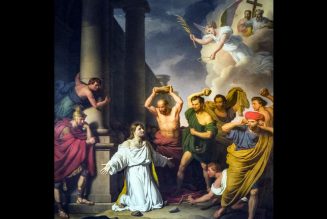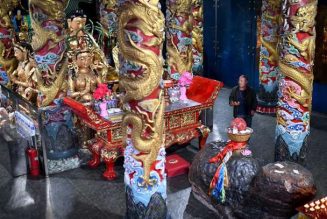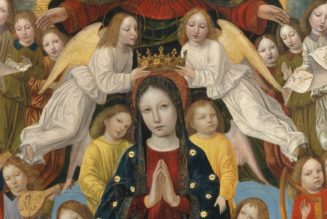
Tour guide K. Troy has been leading pilgrim groups to Catholic shrines across Europe for over twenty-five years now. And he has many stories to tell. His book In the Stars the Glory of His Eyes: Tales of an Irish Tour Guide in Rome (Ignatius Press, 2023) has been described as “Captivating” by Elizabeth Lev, Professor of Art History; “entertaining” by Cardinal Seán Brady, Archdiocese of Armagh, Ireland; and “engrossing” by Justice Teresa Doherty, High Court of Sierra Leone.
Troy recently corresponded by email with CWR while leading a tour in the Holy Land, answering question about how he became a tour guide, his book, the sites, the saints, and the spiritual core of his work.
CWR: Your book is based upon many experiences you’ve had (as the subtitle states) an “Irish tour guide in Rome.” How does someone from Ireland become a tour guide in Rome? What’s the back story? 
K. Troy: From 1993 to 1995, I was a student at the Irish College in Rome. That gave me some familiarity with things and I began working as a courier in Italy for an Irish tour company in 1997. In 1999, Laura and I started going out and we were married in 2000. In 2001, we started our own travel company, originally specialising in pilgrimages to Rome, but now going to many other places.
CWR: How did the book come about, and how did you go about selecting stories to tell?
Troy: In 2005, we were blessed to organise a pilgrimage for a very special priest called Father Sean Higgins. He planned his parish trip meticulously, but died a few days before the group travelled. Other things happened that made it seem like this trip would be an absolute impossibility, or at best, a disaster, but in the end everything worked out wonderfully.
During that week in Italy, there were a number of striking coincidences or “God-incidences” that made us feel that Fr Higgins was interceding for us from above. I wrote the story down a couple of years later and every now and then would show it to people. The general reaction was that it should be published, but I wasn’t sure how to get a single story standing by itself like that into print.
Eventually, over a period of nearly fifteen years, I gathered another eight stories, some of them just as remarkable as what had happened during Fr Higgins’ trip. During Christmas of 2019, I sent them to Joseph Pierce and asked for his opinion. He very kindly send the manuscript to Ignatius Press with a recommendation that it be published.
The stories in the first book were chosen for various reasons, some to show veneration to Mary, or to highlight the qualities of a particular saint, like Mother Teresa or St Therese of Lisieux. Right now, I have nine more stories gathered together, more or less on the theme of the Eucharist, under the title “I see His Blood upon the Rose – more tales from an Irish tour guide in Rome”. All true stories, and better written I think that those in the first book, but I don’t know if anyone will publish it!
CWR: It’s evident, from the start, that you interweave the practical “rubber meets the road” aspects of your work with a deep sense of the presence of God and the saints. First, the practical: what are some of the challenges and inner workings of leading pilgrimages? Are there unique hurdles involved in working in Rome and, at times, with the Vatican?
Troy: The best part of a pilgrimage is being with the pilgrims going to the holy places, but it’s also the hardest part.
When people phone to book on a trip, most questions are about the quality of the hotel, the time of the flight, and what there is for breakfast. It’s very rare that anyone asks anything about the spiritual significance of the places we visit. I would like to think that a pilgrim should be willing to sleep on the floor and live on bread and water to be in some of these places, but many who travel with us are mainly preoccupied with comfort. Obviously, trips can cost a lot of money and people are entitled to decent accommodation and proper food, but it helps when you meet pilgrims who have their priorities in order. Thankfully, many people on these trips are the salt of the earth, with some suffering from illness or bereavement.
The greatest challenge of organising pilgrimages nearly always comes down to dealing with the more fussy individuals. I spend a good deal of time on the phone trying to convince people not to travel with us and to opt instead for one of our competitors. Sometimes I convince entire groups to travel with our rivals if I don’t like the sound of them. It’s very wicked of me, I confess.
We haven’t encountered any particular hurdles in Rome or the Vatican that you wouldn’t find in other places. Italy does have a culture of bureaucracy, so sometimes the booking of Masses can involve a bit more work.
CWR: Secondly, the spiritual aspect: how important are prayer and an active spiritual life in doing your work? How does your relationship with Christ and the saints inform what you do?
Troy: Over the years Laura and I have probably grown in to the spiritual aspect of this work. Every season, a major crisis occurs at some point. That nearly always involves a flight schedule change that makes a trip almost impossible.
We just had our annual crisis last week when British Airways cancelled our connecting flight back from the Holy Land and left us apparently without options. A full refund from the airline is not much use to you when an entire trip for sixty people collapses. Crises like these have been a school of trust for us. So many elements of travel are out of our hands and we have come to realize that our only sure anchor is the Lord. We have learned to consecrate all of our trips to the Lord through Our Lady. Things don’t generally work out as we plan them, but they always work out for the best.
Apart from this education in radical trust, the fact of being on constant pilgrimage for a couple of decades inevitably has benefits. I am constantly listening to homilies from different spiritual directors on various saints, the Eucharist, Our Lady. It has done Laura and me a lot of good and given us more zeal for wanting to bring people to these holy places and experience them well, not in a superficial manner.
CWR: Are there certain sites and saints that are especially meaningful to you?
Troy: The shrine of Fatima is very meaningful for our family because our three children were each born one hundred years after the three visionaries of Fatima. When we went to Fatima in 2017, our children had the exact same ages as Lucia, Francisco and Jacinta in May 1917 at the first apparition.
CWR: There is, of course, a great deal of history involved in your work, as the book demonstrates. What sort of study have you done over the years in that regard? What aspects or eras of history are most popular among pilgrims?
Troy: Any knowledge I have comes from personal reading or from listening to other guides in the places we visit. I have done no formal studies in history or art.
One thing I have learned over the years is that people have a great thirst for spiritual knowledge. As well as that, they love a good historical presentation, whatever the period, The key to keeping people’s interest is perspective. When we are talking about the persecution of the early Church, we should be throwing light on our own situation today. When we talk about St Benedict’s foundation of his monastic order, it should reveal something about what we need to rediscover today. We shouldn’t be afraid of talking to people about the profounder aspects of the places we visit.
Twenty years ago, I probably tended to dumb things down, maybe thinking that it would go over people’s heads. But I have found out that this is not true at all. People are very open and interested in deep theological truths. When we hear them, we sense that they matter in a way that nothing else matters. For example, in Lourdes you can do a simple pilgrimage, pray in front of the Grotto, visit the baths, etc., and all of that is fine and good. But Lourdes is also a great place to talk about the dogma of the Immaculate Conception. Bernadette had been asked by the parish priest to find out the vision’s name. For over a month Our Lady did not answer, but then, on March 25th, feast of the Annunciation – the very day that the Church reads the passage from Luke in which Mary is described as “full of grace” – the vision says, “I am the Immaculate Conception”, a title that Bernadette neither knew nor understood. It is the title of Our Lady that perhaps throws most light on who we are in our fallen state, who God is, how he saves us.
I have discovered that people love to hear about the Immaculate Conception, especially in relation to the simplicity and purity of the little girl to which Our Lady revealed the title. Bernadette was a transparent glass transmitting to us a message from heaven, a message that ultimately is all about our salvation. Pilgrims have a great thirst to be told these things.
To listen to some discussions in the media, one might think that what Catholics most need is to be listened to by the Church, or that some structural thing be changed. But what Catholics really long for is to be catechized in the truths of our faith, just to hear them being proclaimed in their fullness. In Rome, they want to hear a proper discussion of the Petrine ministry, its Scriptural foundation and why it is essential to the Church. There are no better places than Orvieto or Lanciano to talk about the Eucharist and the Catholic understanding of the Mass, its sacrificial nature, and why Eucharistic adoration is so important. In Fatima, if we don’t tell people the importance of the consecration to the Immaculate Heart of Mary, the full story of the apparitions, and how they relate to the rise of communism, the persecution of the Church and the shooting of Pope John Paul II, then we haven’t done our job properly.
These truths strike us in the heart. They’re life-giving and people are aching to hear them. In over twenty years, I have never heard a pilgrim say, “The Church doesn’t listen to me”, but I couldn’t count the number of times someone has said, “Why has nobody told me this before?”
CWR: One theme that shows up quite often is the Incarnation and the relationship of Christ to His Mother. In what ways do you discuss this when leading pilgrimages?
Troy: In Lourdes, there are a series of outdoor chapels to the left of the Basilica of the Rosary which are a good place to discuss the Immaculate Conception and how it relates to the Incarnation. Here there is even a mosaic of Duns Scotus who provided the theological underpinning of the dogma. In Rome, St Mary Major was built following the Council of Ephesus, which involved a very deep theological discussion of the radical nature of the Incarnation. Jesus became so fully human whilst remaining fully God that Mary must be given the title “Mother of God”.
Places like these afford good opportunities to present the teaching of the Church, but there are lots of more informal ways to insert some theology into the tours. A few years ago a priest from Limerick called Fr Joe Young travelled with us to Rome. Though I had never met him previously, I knew that he had been to Lourdes dozens of times and loved St Bernadette, so I decided to talk about the Immaculate Conception at every possible opportunity while this group was in Rome, knowing that he would appreciate it. In Rome there are plenty of opportunities. Piazza di Spagna has the Immaculate Conception column erected after 1854. San Lorenzo has the tomb of Pius IX who defined the dogma.
Anyway, I quickly discovered that people were very interested in the teaching and were asking plenty of questions, some of them very profound. The very next pilgrimage to Rome a week or so later was a parish choir and I continued the policy of talking about the Immaculate Conception at every opportune moment. These were good Catholics, but many did not even know what the title of Our Lady meant. By the end of the week, I heard choir members discussing the dogma of the Immaculate Conception over dinner in Rome!
CWR: Any final thoughts?
Troy: We work mostly with pilgrims and we have been blessed to see the positive effects that pilgrimages often have on people. I think these positive effects generally involve two things, an experience of the mercy of God, and the realisation that God is other – I need to repent if I am going to be in communion with him.
There has always been a tendency towards polarisation in the Church and that happens when these two things are not maintained in balance. On one side, there are those who emphasize the mercy of God but downplay truth, especially the truth that we need to repent. On the other side, there are people who have all of the truths in order. They uphold all the teachings of the Church, but they lack mercy in their attitudes and behaviour, even while paying lip service to God’s mercy.
Obviously, I am just the courier on our trips, not the spiritual director, but I cannot do a presentation of these holy places without having some sort of spiritual key to guide me. For me, John Paul II is the model of truth and mercy in proper equilibrium. That is not an indirect swipe at Pope Francis. I think George Weigel does a great job in The Irony Of Modern Catholic History in showing how the policies of particular popes can sometimes be understood as reactions to events of the day and to the emphases of their predecessors.
Often, such reactions weren’t helpful at the time, but the Lord has a way of bringing about good despite the weaknesses of his ministers. Pope John Paul II had the balance right as far as I am concerned. The more the years go on, the more forthright I am becoming in proclaiming the teachings of the Church whenever it is opportune in these holy places. It can be done without fear. People appreciate it.
If you value the news and views Catholic World Report provides, please consider donating to support our efforts. Your contribution will help us continue to make CWR available to all readers worldwide for free, without a subscription. Thank you for your generosity!
Click here for more information on donating to CWR. Click here to sign up for our newsletter.
